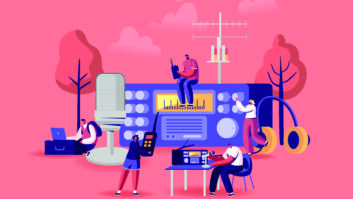In this letter to the editor, the author responds to Kim Andrew Elliott’s recent commentary “Why We Need ‘Shortwave 2.0.’” Comment on this or any article. Email [email protected].
The shortwave debate continued in the recent article by ex-Voice of America executive Kim Andrew Elliot, who makes several very valuable points and also two debatable assumptions.
One is that shortwave broadcasting is “the ultimate internet circumvention tool,” which has a whiff of a subversive to it, suggesting a bit of a dangerous activity at the margins of the legitimate internet world.
Radio, and particularly digital radio, has all the extras (enhanced audio, video and text in several languages) we value in the internet offering, though not its immediacy and vastness; this is fully compensated by its great feature: its anonymity. And this is not to be sniffed at as internet, VPN lines, FM radio programs and even online access can be obstructed by undemocratic regimes or temporarily shut down by natural and man-made disasters.
Shortwave, and particularly digital shortwave (DRM remains the only comprehensive shortwave solution), is a true, be it relatively expensive, plan B which needs to become part of a robust national and even wider international emergency plan. This plan must be driven by governmental and professional entities and not by “enthusiasts and professionals … a reserve corps able to relay information to larger populations in their countries when newer media are blocked or otherwise become unavailable.”
How these technical experts and scholars will alert millions of people, sometimes over large areas, we are not told; and this is a second assumption that does not seem realistic to us.
While shortwave will never recover its prominent position of decades ago, its revived existence, especially with its much-improved digital DRM clothes on, is increasingly recognized, especially in parts of the world which did not or could not introduce so zealously the orthodoxy of internet for all situations, and at all costs.
Not sure a lot of people know about the “radiograms” explained in Mr. Elliott’s article.
And people might also not know that, unlike other digital broadcasting systems, DRM can transmit both audio and texts — or just texts using one or up to four channels — in a normal spectrum allocation used in analog (be it in FM, mediumwave or shortwave).
DRM does not always require new transmitters. A recent announcement came out about the upgrading of an older generation shortwave transmitter at Kajang, south of the Malaysian capital, Kuala Lumpur, which has been broadcasting to the world since the 1970’s. Using its new DRM/AM exciter LVE, RFmondial, a DRM Consortium member company, will replace a malfunctioning Transradio DMOD3, which was feeding a Continental Electronics shortwave transmitter located at Kajang. A new exciter (and this is a revolutionary new thing) revitalizing an old transmitter is much cheaper than a completely new transmitter, and a good way to breathe life into shortwave.
In several parts of the world, investing in new shortwave transmitters is considered essential nowadays. This year, Radio New Zealand is replacing one of its two old shortwave transmitters with a state-of-the art Ampegon analog/DRM transmitter to provide information and, potentially, emergency alerts to the Pacific islands often battered by natural disasters.
RNZ Chief Executive and Editor in Chief Paul Thompson said recently that the importance of the service for the region cannot be underestimated: “Our voice reaches and is welcomed in all parts of the Pacific. During the Tonga eruption, when the undersea cable was cut, RNZ Pacific shortwave was a lifeline source of information,” he said.
Mr. Elliott makes the good point that international broadcasters should not close any more shortwave transmitting sites, as shortwave reception has qualities that even the internet cannot match (anonymity, no need for electricity, etc.). The solution is to broadcast good audio and texts in various languages for different populations (visitors and the visually impaired) [with] graphics and video in DRM.
New digital receivers can receive alarms even when in stand-by. Therefore, marketing new digital receivers is a better idea than simply improving analog shortwave ones, as any digital receiver already features analog reception.
Getting new receivers out in the market remains a huge task, but [it is] an easier and more feasible one than getting noisy analog audio digitized into text in a cell app to be programmed and installed using the very internet which might be censored or blocked by evil dictators.
We agree with Mr. Elliott that international and national broadcasting without radio capability looks like dead trees without branches, decaying in a hostile forest.
The author is chairman of the DRM Consortium. Her commentaries appear regularly at radioworld.com.
[Check Out More Letters at Radio World’s Reader’s Forum Section]












